'The ideal bean-to-cup coffee machine for busy homes' – the Breville Barista Signature tried and tested
Our Breville Barista Signature Espresso Machine review uncovers why this easy-to-use bean-to-cup machine is the ideal choice for busy homes

An easy-to-use bean-to-cup coffee machine that enables you to tweak your espresso to your personal preference without too much faffing. Perfect out-of-the-box operation for busy homes and bean-to-cup novices, with enough customisation options for coffee aficionados to fine tune their brew.
-
+
Perfect for busy homes and bean-to-cup novices
-
+
Very user-friendly
-
+
Very little mess
-
+
Excellent automatic dosing option
-
+
Easy-to-read digital display
-
+
Dual-cup coffee making
-
+
Adjustable milk frother
-
+
Customisable settings for the coffee aficionado
-
-
Some noise and vibration of the drip tray during extraction
-
-
Portafilter hard to twist into the group head without some brute force for the first three months (However, once bedded in this works fine)
Why you can trust Ideal Home

Quick Menu
1. Specifications
2. Unboxing
3. Set up
4. Grinding
5. Dosing
6. Tamping
7. Extraction
8. Milk frothing
9. Other functionality
10. Cleaning
11. Comparisons
12. Verdict
Along with Sage and De'Longhi, Breville is one of the leading names in bean-to-cup coffee machines, and this Breville Barista Signature Espresso Machine review puts one of the brand's latest launches through its paces. The aim? To see if it's worth a spot on our round-up of the best bean-to-cup coffee machines.
Sleek and minimalist in its design, the Breville Barista Signature Espresso Machine is perhaps the most contemporary looking of the brand's coffee machine range, with a design-led black digital display panel that takes centerstage on the front of the stainless steel machine.
The bean-to-cup coffee maker is fitted with a large 58mm group head that Breville says is 'inspired by commercial coffee machines to give better extraction for maximum espresso flavour', and a 'Dual Thermoblock heating system' alongside dual-cup functionality that enables the extraction of two espressos at once, as well as simultaneous frothing of milk with the integrated steam wand.
The 'intelligent' bean grinder offers a wide range of 30 grind settings, along with the option of automatic dosing for ease and speed, and a precision extraction timer that promises to display real-time results on the LED screen to help you to fine tune your grind.
The 'Less Mess Grind' anti-static technology also claims to keep coffee grounds on the drip tray, rather than landing on the countertop, for minimal cleaning.
Overall, the Breville Barista Signature Espresso Machine promises a lot, so we were eager to put it to the test to see if it would impress both the bean-to-cup novice and the more seasoned bean-to-cup aficionado. And, we certainly weren't disappointed.
Read on to find out why we think this smart bean-to-cup machine is well worth the investment, particularly if you're looking for a user-friendly machine that delivers a great bean-to-cup coffee with speed, ease, and minimal fuss.
Sign up to our newsletter for style inspiration, real homes, project and garden advice and shopping know-how

Breville Barista Signature Espresso Machine review
Specifications
- Dimensions: H41.5 x W31 x D33cm
- Weight: 11.2kg
- Capacity: 250g bean hopper, 2.8L water tank
- Included: stainless steel portafilter, tamper, stainless steel milk jug, single and double espresso single and dual wall filter baskets, cleaning accessories
- Grind settings: 30
- Options: Single or double shot, hot water, milk frother
- Adjustable features: dose volume, shot volume, extraction water temperature, extraction pre-infusion profile, grinder recalibration
- Colours: black/stainless steel


How I tested

I'm Amy, one of the Ideal Home team's Ecommerce Editors. My job involves putting all manner of products through their paces to find the best recommendations for our readers, and in this case, that meant putting the Breville Barista Signature Espresso Machine to the test. I consider myself a coffee lover, but until this point I hadn't used a bean-to-cup machine before, so I was eager to see how easily I picked up the knack of grinding my own beans, and whether the results would tempt me into swapping out my humble cafetiere for one of these investment machines. *Spoiler alert: after a month of bean-to-cup coffee making, there's definitely now no going back*.
Unboxing and first impressions
First things first, it should noted that I'm not a professional barista. I drink a fair amount of coffee and certainly think I can discern a good cup of coffee from a bad one, but previous to testing the Breville Barista Signature Espresso Machine I have to admit, I didn't know my portafilter from my tamper.
After I graduated from the cheapest way to make a cup of coffee at home, which is instant granules (please don't judge me just yet coffee connoisseurs), I graduated on to a pod coffee machine, and then a cafetiere that allowed me more freedom over the type of coffee grounds I could brew, and assuaged my guilt over the packaging wastage that tends to go hand-in-hand with a pod coffee machine.
However, I'd shied away from considering a bean-to-cup machine because I wasn't sure I would really utilise the machine enough to justify those exorbitant price tags, and I didn't really want to devote my spare time to learning about grind settings, extraction times, and pre-infusions.
Therefore it was a bit of a surprise to me when the Breville Barista Signature Espresso Machine arrived on my doorstep, because I certainly hadn't considered how big and heavy a bean-to-cup machine would be.
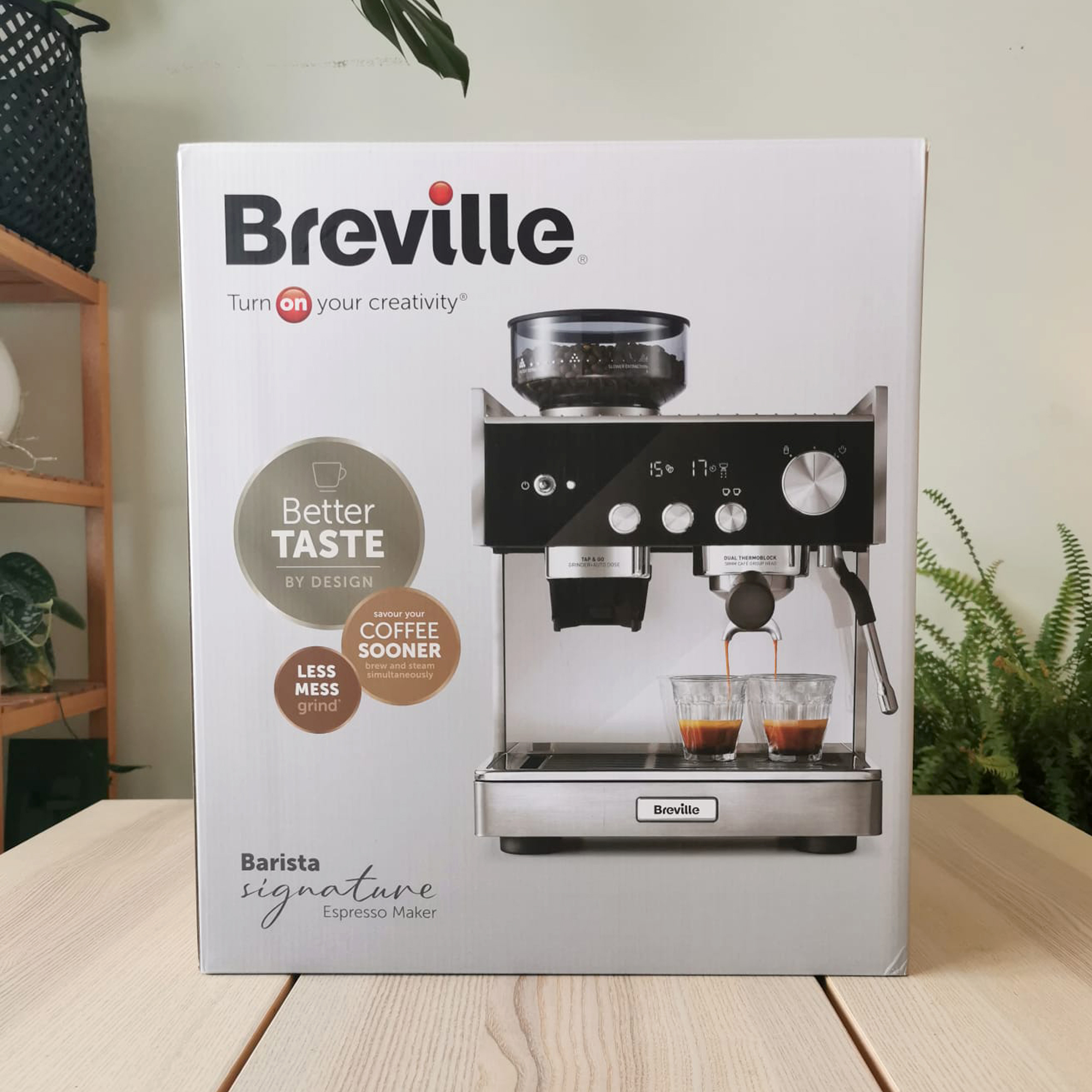
The Breville Barista Signature Espresso Machine weighs in at 11.2kg, so I'd recommend having two people around on delivery day to help get it over the doorstep and into the room of your choice, as well as an extra pair of hands to help unbox it safely.
Despite being heavy to manouvre, I was impressed by the packaging used to protect this machine in transit. Unlike many appliances, the Barista Signature was secured by robust cardboard packaging rather than polystyrene, which is great news on the recycling front.

And once unboxed, the Breville Barista Signature Espresso Machine is even more impressive.
Unlike some bean-to-cup coffee machines – here's looking at you, Smeg EGF03 Espresso Machine – the Barista Signature is only available in one colourway. However, its minimal design with a smart stainless steel body and gloss black digital display is unlikely to disappoint in the style stakes, especially if you have a contemporary home.
Everything on the Breville Barista Signature Espresso Machine feels well made and exudes good quality, and once you realise the body of the machine is all metal, its weight makes a lot of sense.
At an RRP of £669 as of writing, the Barista Signature certainly isn't cheap. But, on unboxing, my first impressions were that it's clear you're getting a great quality appliance for that investment.

Set-up
The hardest part about setting up the Breville Barista Signature Espresso Machine is shimmying it out of its box. After that, set up is fairly minimal and very straightforward.
The instruction manual is informative, and largely well written, although I definitely have a bone to pick with whoever decided to use dark grey type on a mid grey background as this makes the already small text far harder to read than is necessary. (Please reprint using good old black and white Breville!).
But, beyond that, all the components needed for assembly are well labelled and very easy to slot into place.

Breville recommends washing all the components before their first use. After that you need to insert the top burr into the grinder and rotate it clockwise to lock.
At the back of the drip tray there's a handy little cubby hole where the Barista Signature's cleaning tools hide out of sight, and there's space under the drip tray for the removeable grinds bin which allows you to sweep any loose grounds that fall out of the portafilter during grinding neatly away out of sight.
Once the cleaning tools and grinds bin are in place the drip tray slides smoothly into place.
Then you need to add the bean hopper to the top of the machine. This holds 250g of coffee beans, and can be easily adjusted through 30 grind settings by rotating it clockwise or anti-clockwise.
After that, there's just the water tank to add. This coffee machine comes with a space for a charcoal filter to help purify your water. Breville recommends changing the filter every month, and the long handled filter holder has a handy 'month' dial that you can rotate to remind yourself on which month you inserted the last cartridge.
Sadly there's just one charcoal filter included in the box – considering the cost of the machine it would be nice to have found a few months supply included as standard – although if you want to save the hassle and expense of replacing the filter I imagine you could use pre-filtered water to fill the tank.
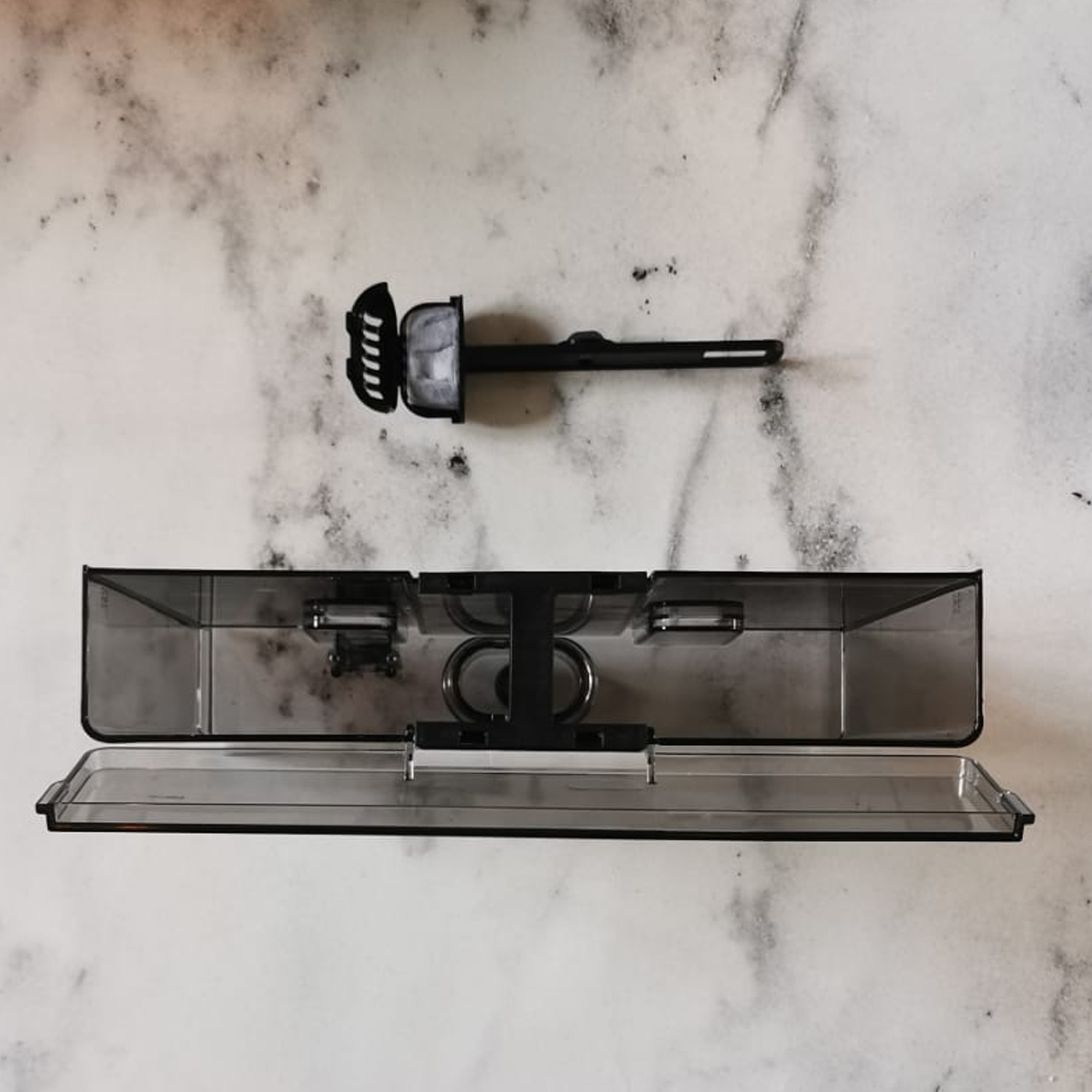
Just like the drip tray, the water tank is really easy to insert. Although, as it's generous – it can hold up to 2.8kg of water – it can be heavy when full, so once fitted it may be easiest to leave it in place and top it up via a jug, asides from when you want to remove it for cleaning.
After that there's a simple 'priming' procedure to follow (a top tip learnt the hard way; make sure the milk frothing nozzle is directly over the drip tray for this stage if you don't want scalding hot steam sprayed all over you or your worktop). And then you're ready to get to the good part – brewing the perfect espresso!
Grinding
Grinding is basically what a bean-to-cup coffee machine is all about, and fine-tuning that grind according to the type of coffee beans that you're using is a large part of what gets you a great tasting brew.
The Breville Barista Signature Espresso Machine has 30 grind settings that you can adjust by turning the hopper on top of the machine from left to right.
If you haven't used a bean-to-cup coffee machine before then that might sound like a lot of options – many bean-to-cup coffee machines we've tested only offer 15 settings – and at this stage you'd be forgiven for starting to feel very out of your depth – I certainly did to start with!
However, if you read the instruction manual then Breville does a good job of talking you through the grind adjustments necessary to create a good cup of coffee, and it quickly becomes a lot more intuitive than it first looks.
The brand recommends starting with your grind setting at 15 which is the median point between coarsely ground and finely ground beans. However, you won't know how well that setting suits your particular brand of coffee beans until you reach the extraction stage... more on that later.
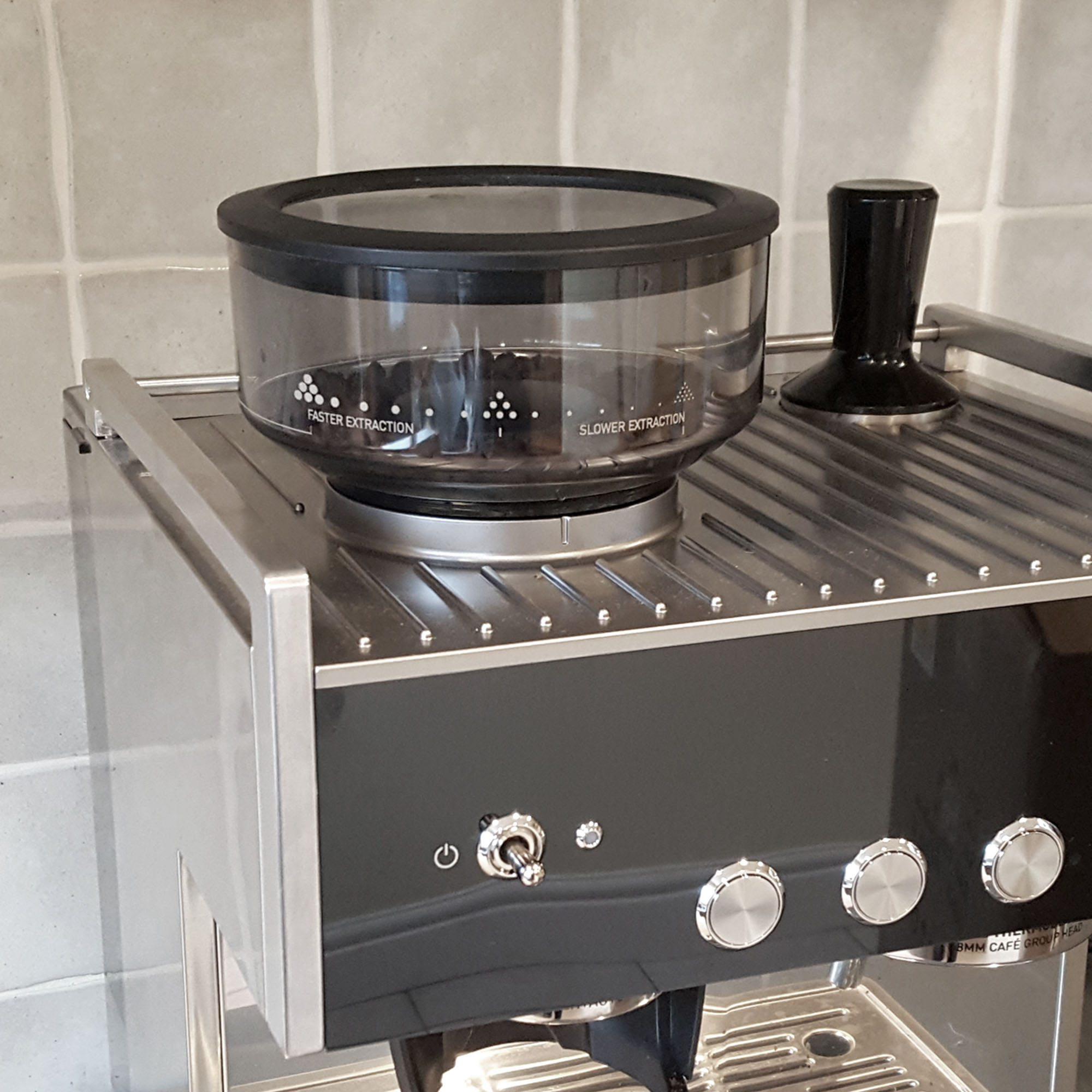
Dosing
A true coffee aficionado might at first be a little non-plussed by the automatic dosing the Breville Barista Signature Espresso Machine offers out-of-the-box, but for me – and likely for any prospective owner who is either short on time or a little inexperienced in bean-to-cup brewing – this is one of its major plus points.
Amongst its accessories – which include a stainless steel milk jug, a coffee tamper and the portafilter – the Barista Signature comes with two filter baskets that can be inserted into the portafilter; a single and double espresso size.

Once inserted into the portafilter and slid into the grinds cradle, the 'Intelligent' grind functionality automatically grinds the correct amount of beans to fit your chosen filter. You just need to let the machine know what size espresso you're aiming for by pressing down on the portafilter's handle once for a single shot and twice for the double.
If you have a busy home, or you just want to enjoy great coffee without putting too much effort into learning how to be a professional barista on day one of ownership, then I think this is a real bonus. I can slot in the portafilter and allow it to fill to the predetermined level I want without standing over the machine waiting for it to dispense the correct amount of grounds.
And that's good, because to start with I had no idea what the correct amount of grounds looked like, so the Signature's default mode was like having bumper lanes on a bowling alley. I think I would have struggled had I started my foray into the bean-to-cup world with a fully manual machine, like the nevertheless very impressive Sage Barista Express Impress.
However, these default settings won't be to everyone's liking, and if you do want more control over your dosing size then Breville has made sure you can easily unlock the professional barista-level settings on the Signature.
In fact, as you gain more skill and confidence in what makes a good brew, you can adjust all manner of settings on the Signature, including dose volume, shot volume, extraction water temperature, and extraction pre-infusion profile.
To adjust your dose volume you can either push down on the portafilter handle and hold it down until you've dispensed your ideal dose size, or customise the machine's factory settings as descibed in the instruction manual.
Another nice touch is the illuminated grind area that helps you to see exactly how many grounds you're dispensing into the portafilter if you're doing things manually.
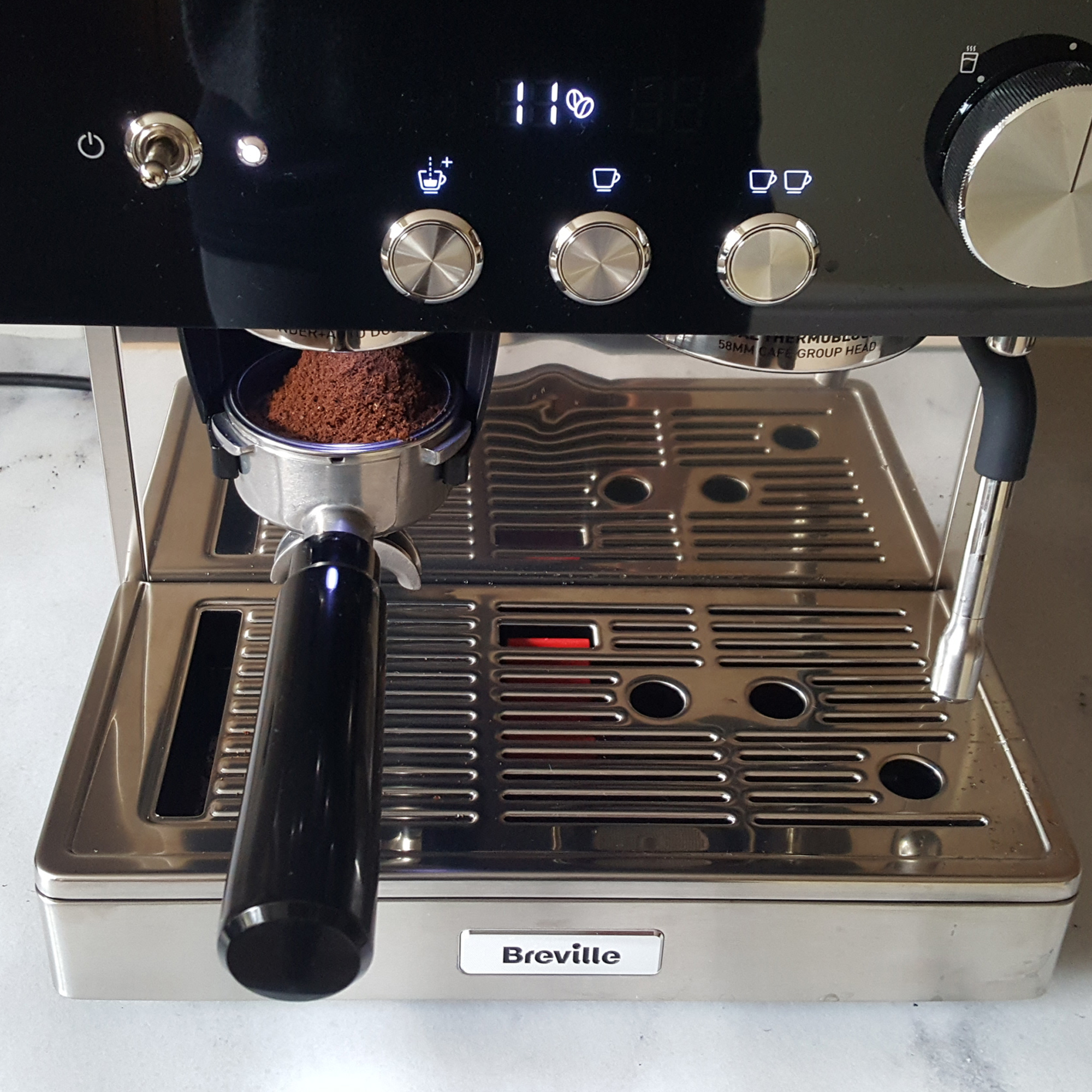
Tamping
Once your portafilter is filled with grounds you'll need to tamp them down to flatten the grind mound ready for extraction.
The Breville Barista Signature Espresso Machine comes with a manual tamp, which personally I really enjoyed using. Other bean-to-cup coffee machines offer automatic tamping, but tamp force is one of the main variables in creating an espresso that's just to your liking, and as it's a very simple procedure I enjoyed having that bit more involvement in the coffee making process.
The Signature's tamper is relatively weighty and pleasant to hold, reliably yeilding good results in our tests.
A nice added detail is the magnetic tamp holder on the top of the machine that means it won't roll off or go missing.
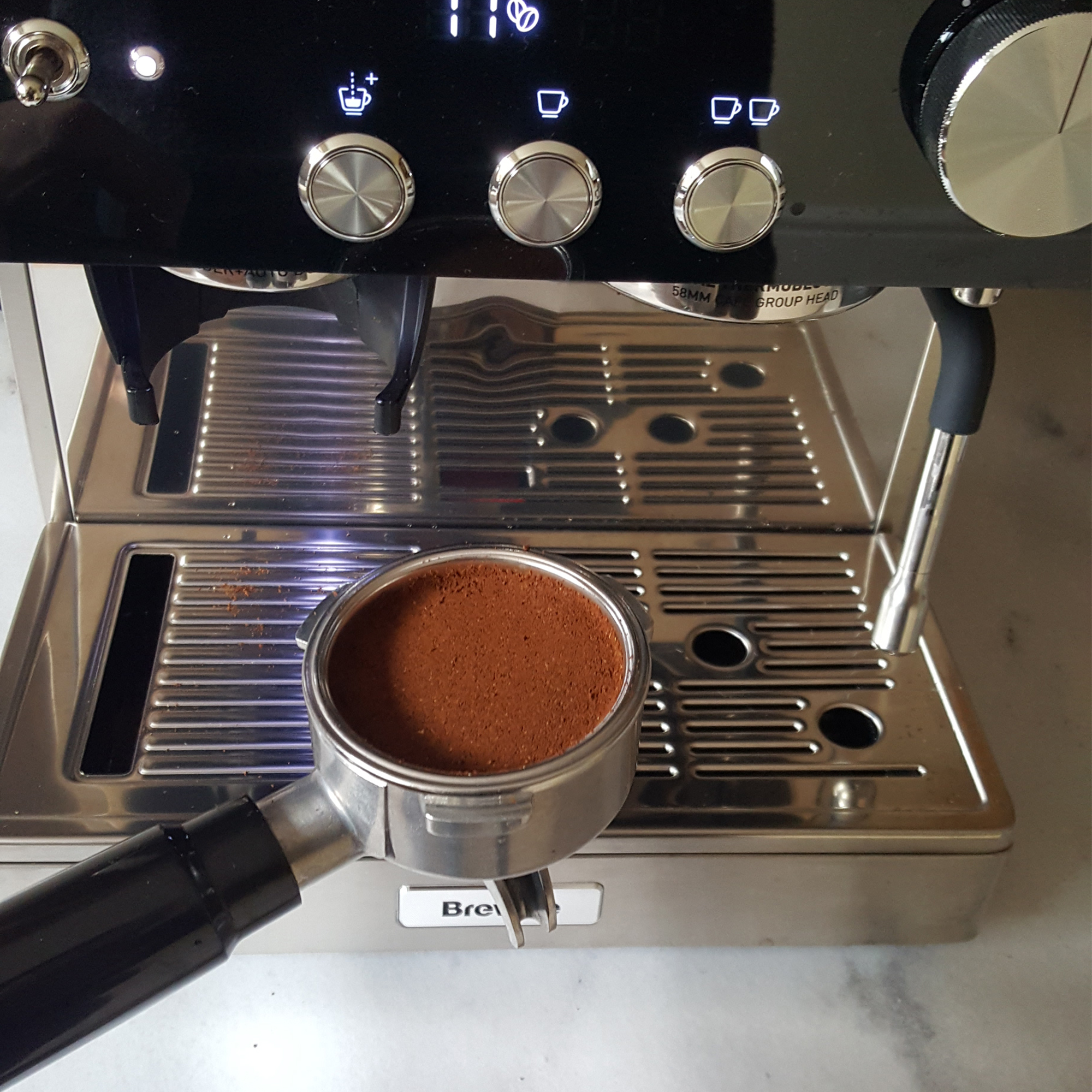
Extraction
To extract your coffee you need to slide the tamped portafilter into the group head on the right of the machine, and then twist the portafilter's handle to the right to get it into position.
At first, this was far easier said than done because the movement is very stiff. The top of the Barista Signature machine has cast aluminium top bars that stick out above the body of the machine, and we soon found that these were vital for holding onto the machine whilst twisting the portafilter into place, otherwise the force necessary to twist the portafilter meant the machine itself moved along the kitchen worktop.
Breville says that this initial tightness is to be expected and caused by the group head silcone seal needing to bed in. The brand says after the first few uses the portafilter will become easier to turn, and it did become easier, although after a month's everyday use I still wouldn't say that twisting the portafilter into position is 'easy'. Although it has loosened up considerably.
*UPDATE* After three months of daily use the silicone seal on the group head has indeed bedded in and the portafilter is much easier to twist into position. It now requires very little effort to turn, so if you are able to persevere through the bedding in process your patience will pay off.
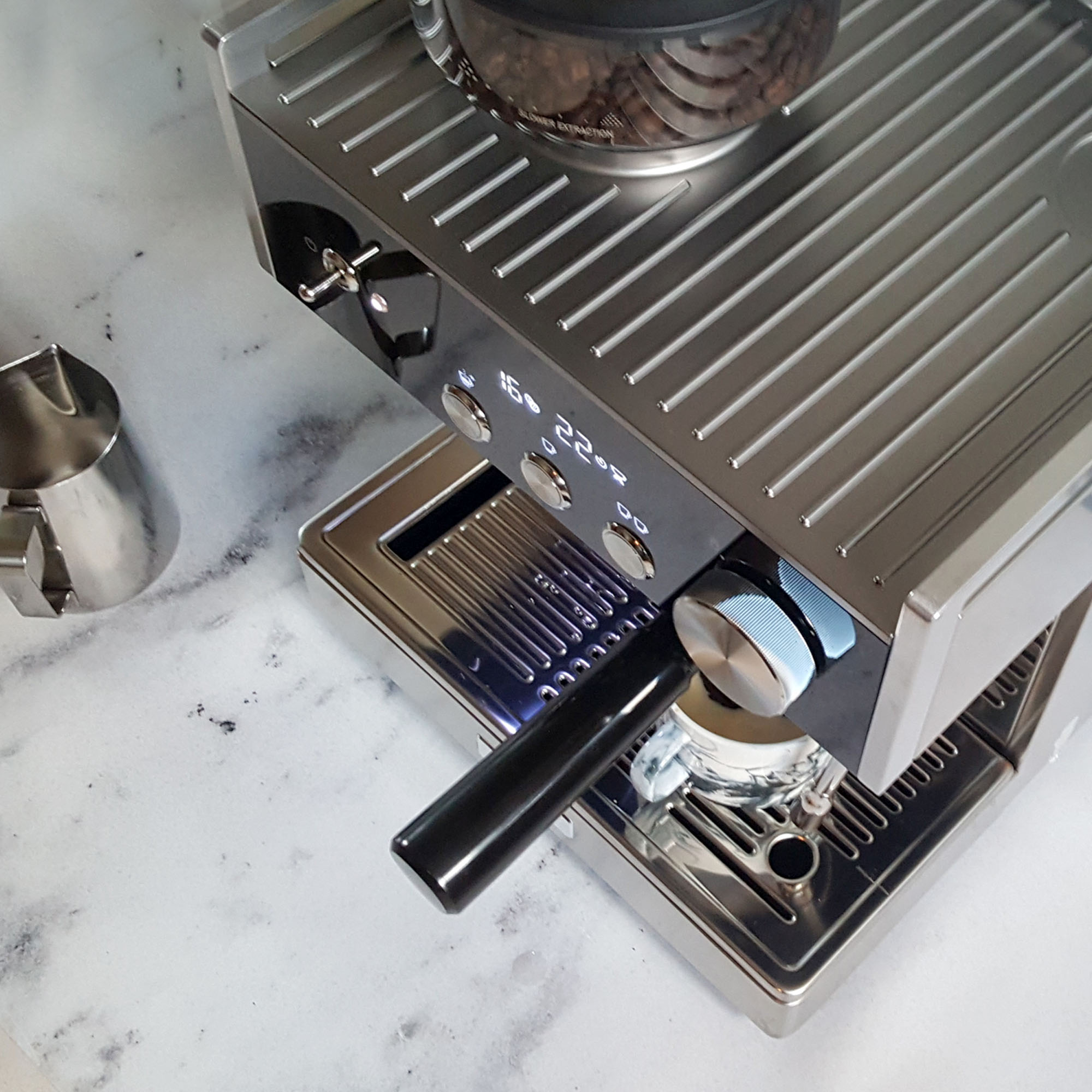
According to Breville, the 58mm group head used on the Signature has been 'inspired by commercial coffee machines to give better extraction for maximum espresso flavour', and it certainly seemed to do the trick once the grind setting was correct.
That's because it's only at the extraction stage that you'll find out if your chosen grind setting suits your coffee beans, and – as with all bean-to-cup coffee machines – this can mean a few dud brews until you dial in the settings correctly.
However, because the Breville Barista Signature Espresso Machine has a digital display, this process is easier, and more precise, than with a lot of bean-to-cup coffee machines.
Many machines, like the Smeg EGF03 Espresso Machine, have a pressure gauge and a needle that fluctuates according to factors like the grind and tamping. Too little pressure (and too coarse a grind or too loose the tamp) and the water runs too fast through the coffee grounds, but too much pressure (which can be caused by too fine a grind or too dense a tamp) and the water struggles to pass through at all.
Adjusting settings based on where you see the needle on a pressure gauge hovering during extraction can be a little tricky. The Barista Signature takes a lot of the guess work out of this process by utilising an extraction timer. This counts in one second intervals whilst your espresso is extracting and communicates the end result clearly on the digital display.

Breville says that the perfect brew should land between 25-30 seconds. So, armed with an exact extraction time from your first brew, you can adjust your grind accordingly, making it finer if the extraction time is too quick, or coarser if the extraction time is too slow. You'll also be able to tell you're getting closer to the optimum results by the quality of the crema on your espresso.
After the first few attempts I found this process really easy to get grips with, which means if you change your coffee beans for a new variety you're not wasting too many beans whilst you're dialling in the settings.
And, once you've found the exact right setting, because the hopper's grind settings are manual, there's no need to make any adjustments each time you turn the coffee machine on.
A minor bug-bear I found with this process is that the extraction time isn't displayed on the digital screen for very long, I would estimate your brew time stays on the display screen for around 30 seconds, so if you don't pay close attention as you're extracting then you can miss this timing feedback. The Signature has a really useful automatic shut-off function which kicks in if the machine hasn't been used for around 20 minutes, so it would be great if the extraction time could remain on the screen for all of this time.
The only other downside I found with the extraction process is that it does make the drip tray vibrate a fair amount – often enough for the coffee cup to move out of position from under the portafilter. It's not a problem if you hold the cup in place for the first 10 seconds whilst the machine begins the extraction process, but it is a bit noisy, and preferably wouldn't happen, although it tends to be common occurence with bean-to-cup machines based on our reviews.
However, after a little initial fine-tuning to find the right grind setting for your favoured coffee bean, there's no doubt that the Breville Barista Signature Espresso Machine reliably delivers a really great bean-to-cup coffee.
Sadly, I think this might mean my good old cafetiere is now redundant. The Barista Signature has definitely converted this bean-to-cup novice into a bean-to-cup fangirl.

Milk frothing
If you love a latte or a cappuccino then you'll love the Breville Barista Signature Espresso Machine's built-in steaming wand.
As a milk frothing newbie, it definitely took me a while to get to grips with how to froth my milk to perfection, but, again, the instruction manual offers some top tips for getting this step just right.
The wand also offers a good degree of manoeuvrability that allows you to tilt the stainless steel milk jug (that comes included) so you can get a good steaming angle. However, as a right-handed person, I'm not sure how easy a left-handed user would find this process. It's great having the steam wand included, but, if you're a keen frother you might prefer a stand-alone milk frother for full flexibility.
One extra bonus to the Breville Barista Signature Espresso Machine is its 'Dual Thermoblock' heating system which means you can brew and steam simultaneously. Although seeing as brewing should take at maximum 30 seconds, I'm not sure how much time this really saves, but still, if you're in a rush to leave the house in the morning then every second counts!
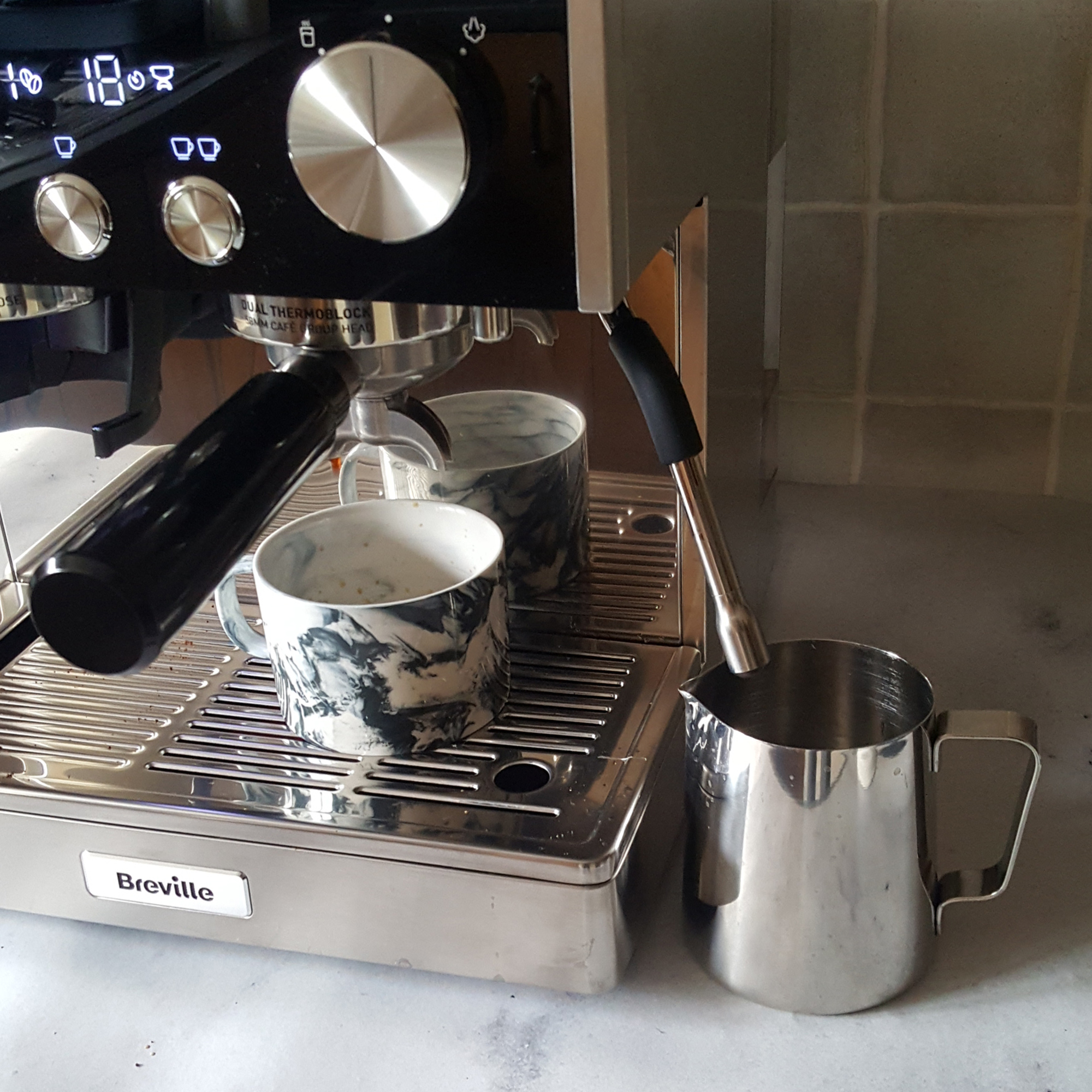
Other functionality
One of the big bonuses of the Breville Barista Signature Espresso Machine is the fact its dual-cup dispenser can brew two espressos at once – perfect if you want to enjoy a hot coffee in tandem, and great if you're looking to save time in the mornings when making a espresso for more than one person at a time.
Plus, should you prefer to ditch the milk, then the Breville Barista Signature Espresso Machine also offers a handy hot water dispenser for Americanos.
As mentioned, its auto shut-off functionality is also great, and another bonus for busy households – you can just make your coffee and get on with your day whilst the Signature looks after itself and shuts down to save energy.
Another great feature is the machine's anti-static technology that keeps grounds where they belong – in the grinder, not on your counter. I have no idea how this anti-static functionality works, but work it does. Even with the window open and a few loose grounds on the drip tray after grinding, loose grounds didn't ever seem to blow onto the counter.
That means there's very minimal cleaning up to do after every brew. All you need to do is use a damp cloth to wipe over the drip tray and swipe any loose grounds into the recessed grind bin – a far cleaner process than some other machines we've tested, and ideal for busy homes.

Cleaning
Urgh, cleaning. In my opinion always that's always the biggest downside of using any kitchen appliance!
However, I've been really pleasantly surprised by how easy the Breville Barista Signature Espresso Machine is to look after.
After each use you need to empty out the used grounds from the filter basket and give both the basket and the portafilter a quick rinse. However, because the grounds are compacted and relatively dry I actually found this a much easier process than when using the cafetiere that I'm used to, as I can tip the used grounds straight into my food recycling bin with no watery mess.
Beyond that, daily cleaning just requires a quick wipe of the drip tray to keep the Signature looking sparkling.
The anti-static technology does a great job of keeping any stray coffee grounds on the drip tray, and the grind bin is brilliant for quickly sweeping any loose grounds into as you wipe over the drip tray.
Of course, as with any stainless steel appliance, there are fingerprints to consider, but none of the metal sections of the Signature are areas you would really touch during normal use, so the machine ended up with very few – if any – smears after a month's daily use. Plus, any marks can easily be buffed out, so the Signature is very low maintenance – great news if you're worried that the (usually high maintenance) stainless steel body might trigger some cleaning OCD!
Handily, the drip tray features a clever red 'flag' that rises as the water level in the drip tray does to alert you when the drip tray needs emptying, although after a month's use this still hadn't popped up, so again, this isn't a task that you'll need to do that often. And, thanks to the drip tray's solid build and smooth motion, it's really easy to take out of the machine and empty.

Beyond this the instruction manual explains how to clean each component of the machine, and how often to do so, but all processes are quick and easy to perform.
The Signature also features an indicator which will alert you when the machine requires a full cleaning cycle. Instructions for how to perform this are straightforward, and performing this operation will help to prolong the lifespan of the machine.
How does it compare?
I found the Breville Barista Signature Espresso Machine's digital interface super easy to use, and really liked its minimal controls that meant I didn't feel overwhelmed by options.
I also really liked the fact that its default automatic dosing feature meant that – as a novice bean-to-cup novice – I could make great tasting coffee quickly and easily, whilst knowing that there were a whole other level of customisation options waiting to be unlocked if I so wished.
And, the Signature has plenty of fine-tunements available if you are more of a coffee brewing enthusiast, including dose volume, shot volume, extraction water temperature, and extraction pre-infusion profile (there are three pre-infusion settings; 'gentle', 'distinct' and 'constant'). All-in-all plenty of freedom for the coffee aficionado to perfect a perfectly balanced brew.
The Signature's anti-static drip tray is also a brilliant addition, and kept work surfaces super clean – perfect for busy homes, and a big improvement on the excellent, but slightly mess-prone, Breville Barista Max+ in this regard.
However, if you're a budding barista and prefer a 'classic' look, you may prefer the more hands-on feel of the Sage Barista Express Impress. This impressive machine features a traditional pressure gauge and takes a little more user input to create a great coffee – which might perhaps appeal more to the coffee enthusiast. The Impress also features automatic tamping, unlike the Signature's manual tamp process.
However, if you want a great tasting bean-to-cup coffee at home with minimal fuss and bother, I really rate the Barista Signature.
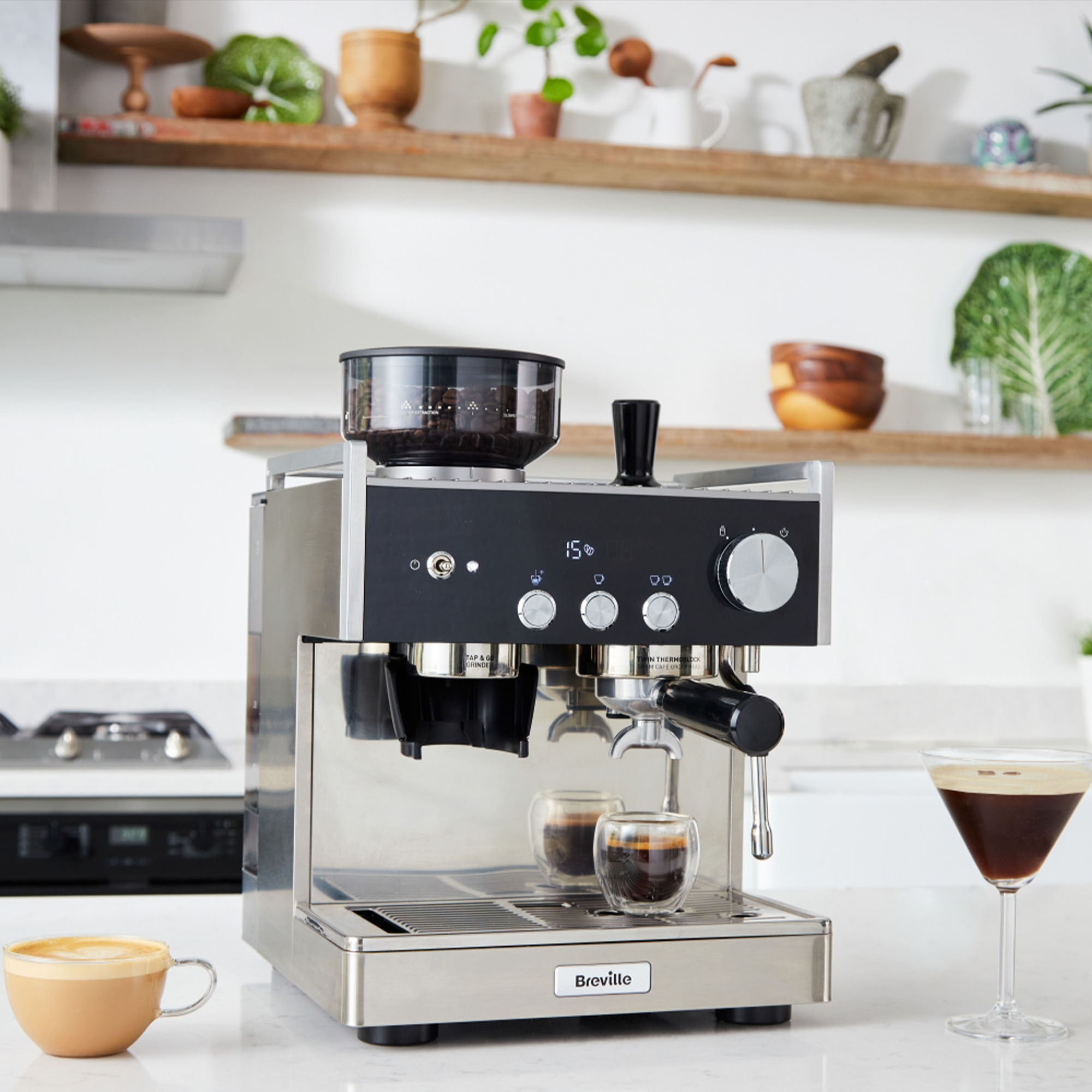
That said, just like the Sage Barista Express Impress, this machine is pretty large. And if you're a bean-to-cup novice like me, I would definitely recommend making the size of the machine one of your first considerations pre-purchase.
The coffee machine's weight may not be a major issue after delivery day as – although the 11.2kg Breville Barista Signature Espresso Machine needed two of us to unbox it – you're not likely to moving your coffee machine that frequently once it's set up, but the footprint and height of the coffee machine will impact its ease of use.
It's particularly worth noting where the hopper and water tank sit on the machine so that both will be relatively easy to access based on your kitchen layout.
If you have a small kitchen, like me, then the Barista Signature is going to take up a decent chunk of work surface, and although it's not the largest bean-to-cup machine on the market, I did find its H41.5 x W31 x D33cm dimensions meant it was a very tight squeeze to fit under my wall hanging kitchen cupboards. Ideally, you want to position this coffee maker where there is free space above it so you have easy access to refill the bean hopper and the water tank.
It's the hopper that adds a lot of that height, so if space is an issue a more compact machine like the Beko CEG5311X Bean to Cup Coffee Machine could be a better fit. The Beko is also significantly cheaper, although, in my opinion, its far more basic design doesn't offer much in the style stakes, and its much more basic functionality likely won't impress those who want a bit more bang for their buck.

Verdict
If you want the ability to make a great bean-to-cup coffee at home, but without the need for full-on barista training, then I think the Breville Barista Signature Espresso Machine is the perfect option.
Its default settings are ideal if you're a grinding newbie or don't have the time to master multiple settings, but if you're a coffee connoiseur then there are also a whole other level of 'hidden' customisation options you can access to enable you to control pretty much every aspect of your brew, including dose volume, shot volume, extraction water temperature, and extraction pre-infusion profile.
The Signature is super easy to use, with a user-friendly digital display and a simple interface that doesn't overwhelm. It also offers the ability to make two espressos at once, and you can froth your milk as the coffee is being extracted so you get a hotter drink and save yourself some extra seconds in the morning. Plus, the Breville Barista Signature Espresso Machine looks great on the countertop.
All importantly, the Signature also makes really great coffee, and if your mornings are busy then its simplicity means you can extract a powerful and flavoursome coffee without any faffing, whilst its anti-static drip tray means there's barely any clean up to do after each use.
The only real downsides uncovered in our tests were that the extraction process on the Signature is a little noisy and causes the drip tray to vibrate. That can mean that the coffee cup shudders out from under the portafilter's dispensing nozzles if your attention is distracted – although holding the cup in place for 10 seconds likely won't be much hardship. Beyond that there's just the fact that the portafilter is very hard to twist into the group head for the first few uses, although it does ease with repeated use.
However, those little niggles definitely don't detract from the fact that the Breville Barista Signature Espresso Machine is a great bean-to-cup coffee maker. I've been thoroughly impressed by its performance.
The Breville Barista Signature Espresso Machine has certainly converted me into a bean-to-cup fan, and this machine has proved itself perfect for busy homes, allowing the super-fast extraction of coffee-shop standard coffee with minimal mess or effort (unless you want to put more effort into tweaking those settings).

Amy is Ideal Home’s Sleep Editor and the Ideal Home Certified Expert on Sleep. She's spent the last four years researching and writing about what makes for the best night’s sleep during the day and testing out sleep products to find the best-in-class by night. So far she’s clocked up over 10,000 hours of pillow, duvet, and mattress testing experience.
Our go-to for all things sleep-related, she’s slept on and under bestselling products from Simba, Emma, Hypnos, Tempur, Silentnight, Panda, and many many more.
As a hot sleeper, Amy is always on the lookout for the most breathable bedding, but she also leads a wider team of testers to ensure our product testing encompasses both hot sleepers, cold sleepers, front sleepers, back sleepers, side sleepers, and everything in-between.